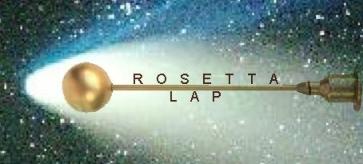
IRF Uppsala
...English
...Svenska
Space Plasma Physics
...English
...Svenska
Rosetta (English)
...Home
...Mission
...Timeline
...Science
...LAP team
...RPC team
Rosetta (svenska)
...Hem
...Projektet
...Tidtabell
...Vetenskap
...LAP-gruppen
...RPC-gruppen
...Galleri
Tech pages
Team pages (restricted)
| INSTITUTET FÖR RYMDFYSIK | Space Plasma Physics programme, UPPSALA |
 |
|
| Swedish Institute of Space Physics | (59o50.272'N, 17o38.786'E) |
 |
Rosetta is an ambitious project catching up with a comet, following it in its orbit for two years (2014-2016), putting a lander (Nov 2014) and finally itself onto the surface of the comet nucleus. Our onboard space weather station LAP was active from start to end! |
| Back to Rosetta LAP home page |
Science with LAP
The basic goal
of Rosetta is to study the origin of comets, the relationship between
cometary and
interstellar material and its implications with regard to the origin of
the Solar System. The main task of LAP is to investigate, together with
all the other
sensors of the Rosetta
Plasma Consortium (RPC), the
plasma environment of the
comet, to solve riddles related to the comet nucleus itself as well as
to its interaction with the solar wind. The basic parameters measured
by LAP are the density,
temperature and
flow speed
of the plasma,
but other parameters can also be estimated (read more on LAP
capabilities below). We fly a similar
instrument, though with one probe only, on the Cassini
spacecraft now orbiting Saturn.LAP capabilities
A plasma is a gas of consisting of charged particles. The basic idea of a Langmuir probe is to determine the density of a plasma in the following way:
- Put a conducting probe in contact with the plasma (we use nitrified titanium spheres).
- Apply a voltage on the probe (a bias voltage).
- Measure the current flowing to the probe from the plasma. The denser the plasma, the higher the current. Voila!
- What can be done by one Langmuir probe
- What can be done by two Langmuir probes
- What can be done by two probes
Science studies
There is still a long way to go to the comet, but we already have some results published:- When Rosetta flew by Mars in February 2007, we observed the bow shock forming around the planet when the solar wind flows by. The same bow shock was almost simultaneously observed also by Mars Express. The work was published by Niklas Edberg in Planetary and Space Science (2009).
- We have also published an instrument description in Space Science Reviews (2007).
- Various aspects of comets, Rosetta and LAP have been studied in a series of undergraduate projects:
- 2011: Ilona Alexandersson, Far comet ion tails
- 2010: Christian Hånberg, Parametric modelling of Rosetta spacecraft potential measurements
- 2009: Alexander Sjögren, Modelling of Rosetta Langmuir probe measurements
- 2009: Kristoffer Hultgren, Rosetta LAP operations at the target comet
- 2006: Niklas Edberg, The Rosetta Mars flyby
- 2006: Claes Weyde, Plasma parameters from the Rosetta LAP instrument
- 2005: Sofie Spjuth, Rosetta encounters with comet ion tails
- 2005: Magnus Billvik, The Rosetta Earth flybys
- 2004: Mathieu Lonjaret, Initial data from the Rosetta LAP instrument